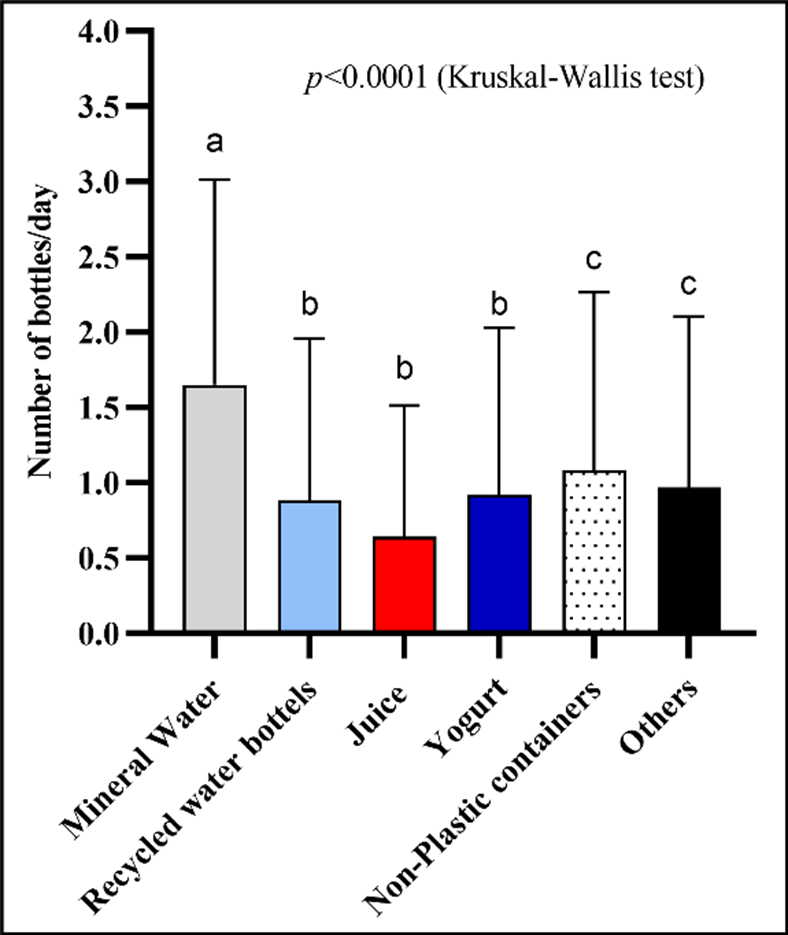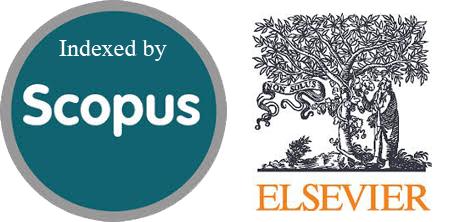Public Awareness and Knowledge Regarding Toxicovigilance of Xenoestrogens in Iraq: A Cross-sectional Study
DOI:
https://doi.org/10.54133/ajms.v9i2.2419Keywords:
Bisphenol A, Endocrine disruptors, Healthcare awareness, Iraq, XenoestrogensAbstract
Background: Xenoestrogens are synthetic chemicals found in various plastics, sealants, consumer goods, preservatives, and pesticides. They can disrupt the endocrine system and have been linked to numerous health issues, including reproductive problems, hormonal imbalances, developmental abnormalities, and an increased risk of certain cancers. Objective: To identify the awareness, knowledge, and usage rate of XEs among individuals in different Iraqi governments and the human risk assessment for potential toxicity. Methods: This descriptive cross-sectional study utilized a random convenience sampling method from January to June 2024 throughout various regions of Iraq. Participants aged 18 to 70 years who provided verbal consent were recruited prior to enrollment in this study (n=304). The participants filled out the questionnaires in the presence of researchers, who then collected them for assessment. The questionnaire, partially modified from a prior study, gathered data on educational status, basic knowledge, and awareness of xenoestrogens and their health effects, as well as the safety and frequency of use of containers presumed to harbor xenoestrogens. Results: The findings will provide insights into the level of awareness and knowledge among healthcare providers, medical students, and academic professionals in Iraq regarding xenoestrogens and their potential health risks. Detailed results will be analyzed to determine the extent of knowledge and gaps that need to be addressed. Conclusions: Most of the Iraqi people did not have enough awareness and knowledge of XE's effects on general health and the environment. This highlights the importance of improving knowledge and awareness about these chemicals.
Downloads
References
Wang X, Ha D, Yoshitake R, Chan YS, Sadava D, Chen S. Exploring the biological activity and mechanism of xenoestrogens and phytoestrogens in cancers: Emerging methods and concepts. Int J Mol Sci. 2021;22:8798. doi: 10.3390/ijms22168798. DOI: https://doi.org/10.3390/ijms22168798
Paterni I, Granchi C, Minutoloa F. Risks and benefits related to alimentary exposure to xenoestrogens. Crit Rev Food Sci Nutr. 2017;57(16): 3384–3404. doi: 10.1080/10408398.2015.1126547 DOI: https://doi.org/10.1080/10408398.2015.1126547
Kerdivel G, Habauzit D, Pakdel F. Assessment and molecular actions of endocrine-disrupting chemicals that interfere with estrogen receptor pathways. Int J Endocrinol. 2013;2013:501851. DOI: https://doi.org/10.1155/2013/501851
Wendy Y, Chen MD. Exogenous and endogenous hormones and breast cancer. Best Pract Res Clin Endocrinol Metab. 2008;22:573–585. DOI: https://doi.org/10.1016/j.beem.2008.08.001
Lee HJ, Chattopadhyay S, Gong E, Ahn RS, Lee K. Antiandrogenic effects of bisphenol A and nonylphenol on the function of androgen receptor. Toxicol Sci. 2003;75:40–46. DOI: https://doi.org/10.1093/toxsci/kfg150
Cimmino I, Fiory F, Perruolo G, Miele C, Beguinot F, Formisano P, et al. Potential mechanisms of bisphenol A (BPA) contributing to human disease. Int J Mol Sci. 2020;21:5761. doi: 10.3390/ijms21165761. DOI: https://doi.org/10.3390/ijms21165761
Seachrist DD, Bonk KW, Ho S, Prins GS, Soto AM, Keri RA. A review of the carcinogenic potential of bisphenol A. Reprod Toxicol. 2016;59:167–182. DOI: https://doi.org/10.1016/j.reprotox.2015.09.006
Lanlan Li, Qianqian Wang , Yan Zhang , Yuzhen Niu , Xiaojun Yao , Huanxiang Liu. The molecular mechanism of bisphenol A (BPA) as an endocrine disruptor by interacting with nuclear receptors: insights from molecular dynamics (MD) simulations. PLoS One. 2015;10(3):e0120330. doi: 10.1371/journal.pone.0120330. DOI: https://doi.org/10.1371/journal.pone.0120330
Yuan M, Chen S, Zeng C, Fan Y, Ge W, Chen W. Estrogenic and non-estrogenic effects of bisphenol A and its action mechanism in the zebrafish model: An overview of the past two decades of work. Environ Int. 2023;176:107976. doi: 10.1016/j.envint.2023.107976. DOI: https://doi.org/10.1016/j.envint.2023.107976
Nicolopoulou-Stamati P, Maipas S, Kotampasi C, Stamatis P, Hens L. Chemical pesticides and human health: The urgent need for a new concept in agriculture. Front Public Health. 2016;4:148. DOI: https://doi.org/10.3389/fpubh.2016.00148
Kabasenche WP, Skinner MK. DDT, epigenetic harm, and transgenerational environmental justice. Environ Health. 2014;13:62. doi: 10.1186/1476-069X-13-62. DOI: https://doi.org/10.1186/1476-069X-13-62
Kumar V, Chandra Yadav CS, Banerjee BD. Xeno-estrogenic pesticides and the risk of related human cancers. J Xenobiot. 2022;12(4):344-355. doi: 10.3390/jox12040024. DOI: https://doi.org/10.3390/jox12040024
La Merrill MA, Vandenberg LN, Smith MT, Goodson W, Browne P, Patisaul HB, et al. Consensus on the key characteristics of endocrine-disrupting chemicals as a basis for hazard identification. Nat Rev Endocrinol. 2020;16:45–57. doi: 10.1038/s41574-019-0273-8. DOI: https://doi.org/10.1038/s41574-019-0273-8
Strong AL, Shi Z, Strong MJ, Miller DF, Rusch DB, Buechlein AM, et al. Effects of the endocrine-disrupting chemical DDT on self-renewal and differentiation of human mesenchymal stem cells. Environ Health Perspect. 2015;123(1):42-48. doi: 10.1289/ehp.1408188. DOI: https://doi.org/10.1289/ehp.1408188
van den Berg H. Global Status of DDT and its alternatives for use in vector control to prevent disease. Environ Health Perspect. 2009;117(11):1656–1663. doi: 10.1289/ehp.0900785. DOI: https://doi.org/10.1289/ehp.0900785
Montano L, Pironti C, Pinto G, Ricciardi M, Buono A, Brogna C, et al. Polychlorinated biphenyls (PCBs) in the environment: Occupational and exposure events, effects on human health and fertility. Toxics. 2022;10(7):365. doi: 10.3390/toxics10070365. DOI: https://doi.org/10.3390/toxics10070365
Ododo M, Wabalo BK. Polychlorinated biphenyls (PCBs) and their impacts on human health: A review. J Environ Pollut Hum Health. 2019;7(2):73-77.
Faroon O, Ruiz P. Polychlorinated biphenyls: New evidence from the last decade. Toxicol Ind Health. 2016;32(11):1825–1847. doi: 10.1177/0748233715587849. DOI: https://doi.org/10.1177/0748233715587849
Tran HT, Lin C, Bui XT, Nguyen MK, Cao NDT, Mukhtar H, et al. Phthalates in the environment: characteristics, fate and transport, and advanced wastewater treatment technologies. Bioresource Technol. 2022;344 B:126249. DOI: https://doi.org/10.1016/j.biortech.2021.126249
Hager E, Chen J, Zhao L. Minireview: Parabens exposure and breast cancer. Int J Environ Res Public Health. 2022;19(3):1873. doi: 10.3390/ijerph19031873. DOI: https://doi.org/10.3390/ijerph19031873
Anjum F, Razvi N, Ghayas S, Naeem A, Nisar A. Knowledge and attitude towards xenoestrogens. World J Pharm Pharm Sci. 2019;8:150-160.
Rouillon S, El Ouazzani H, Rabouan S, Migeot V, Albouy-Llaty M. Determinants of risk perception related to exposure to endocrine disruptors during pregnancy: A qualitative and quantitative study on French women. Int J Environ Res Public Health. 2018;15(10):2231. doi: 10.3390/ijerph15102231. DOI: https://doi.org/10.3390/ijerph15102231
Ho H, Watanabe T. The roles of three types of knowledge and perceived uncertainty in explaining risk perception, acceptability, and self-protective response-A case study on endocrine disrupting surfactants. Int J Environ Res Public Health. 2018;15:296. doi: 10.3390/ijerph15020296. DOI: https://doi.org/10.3390/ijerph15020296
Kelly M, Connolly L, Dean M. Public awareness and risk perceptions of endocrine disrupting chemicals: a qualitative study. Int J Environ Res Public Health. 2020;17:7778. doi: 10.3390/ijerph17217778. DOI: https://doi.org/10.3390/ijerph17217778
Rouillon S, Deshayes-Morgand C, Enjalbert L, Rabouan S, Hardouin JB, et al. Endocrine disruptors and pregnancy: Knowledge, attitudes and prevention behaviors of French women. Int J Environ Res Public Health. 2017;14(9):1021. doi: 10.3390/ijerph14091021. DOI: https://doi.org/10.3390/ijerph14091021
Maniradhan M, Calivarathan L. Bisphenol A-induced endocrine dysfunction and its associated metabolic disorders. Endocr Metab Immune Disord Drug Targets. 2023;23(4):515-529. doi: 10.2174/1871530322666220928144043. DOI: https://doi.org/10.2174/1871530322666220928144043
Dueñas-Moreno J, Mora A, Kumar M, Meng XZ, Mahlknecht J. Worldwide risk assessment of phthalates and bisphenol A in humans: The need for updating guidelines. Environ Int. 2023;181:108294. doi: 10.1016/j.envint.2023.108294. DOI: https://doi.org/10.1016/j.envint.2023.108294
Kalofiri P, Biskanaki F, Kefala V, Tertipi N, Sfyri E, Rallis E. Endocrine disruptors in cosmetic products and the regulatory framework: Public health implications. Cosmetics. 2023;10(6):160. doi: 10.3390/cosmetics10060160. DOI: https://doi.org/10.3390/cosmetics10060160
Canavez ADPM, de Oliveira Prado Corrêa G, Isaac VLB, Schuck DC, Lorencini M. Integrated approaches to testing and assessment as a tool for the hazard assessment and risk characterization of cosmetic preservatives. J Appl Toxicol. 2021;41(10):1687-1699. doi: 10.1002/jat.4156. DOI: https://doi.org/10.1002/jat.4156
Fivenson D, Sabzevari N, Qiblawi S, Blitz J, Norton BB, Norton SA. Sunscreens: UV filters to protect us: Part 2-Increasing awareness of UV filters and their potential toxicities to us and our environment. Int J Womens Dermatol. 2020;7(1):45-69. doi: 10.1016/j.ijwd.2020.08.008. DOI: https://doi.org/10.1016/j.ijwd.2020.08.008
Vitku J, Varausova A, Skodova T, Kolatorova L, Vosatkova M, Vcelak J, et al. The role of 11-oxygenated androgens and endocrine disruptors in androgen excess disorders in women. Int J Mol Sci. 2024;25(17):9691. doi: 10.3390/ijms25179691. DOI: https://doi.org/10.3390/ijms25179691
Hui CK, Kamarudin KS, Yusof H. University students’ knowledge, attitude and practice (KAP) of endocrine disrupting chemicals (EDCs): the use of selected plastic-type food contact materials in Kuala Terengganu. IOSR J Nurs Health Sci. 2017;6:10-16. doi: 10.9790/1959-0601061016. DOI: https://doi.org/10.9790/1959-0601061016
Russo J, Santucci-Pereira J, Russo IH: The genomic signature of breast cancer prevention. Genes (Basel). 2014:5:65-83. doi: 10.3390/genes5010065. DOI: https://doi.org/10.3390/genes5010065

Downloads
Published
How to Cite
Issue
Section
License
Copyright (c) 2025 Al-Rafidain Journal of Medical Sciences ( ISSN 2789-3219 )

This work is licensed under a Creative Commons Attribution-NonCommercial-ShareAlike 4.0 International License.
Published by Al-Rafidain University College. This is an open access journal issued under the CC BY-NC-SA 4.0 license (https://creativecommons.org/licenses/by-nc-sa/4.0/).











